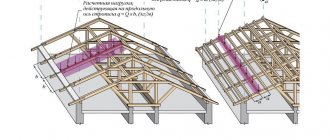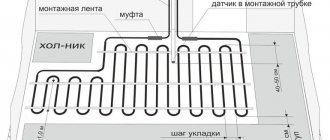When determining what the distance between the refrigerator and the wall should be, most consumers believe that this is not a fundamental issue and is of little importance. Statistics collected from the general experience of manufacturing companies show that the location of a refrigerator plays a huge role in its ability to operate smoothly. Failure to comply with operating rules is the path to rapid failure of the most reliable unit. The work of repairmen who provide warranty repairs to a conventional refrigerator only confirms the existing dependence on the distances to the wall on the side and back.
In the kitchen
Consequences of placing a refrigerator next to a battery
The refrigerator motor can overheat and burn out if you place it next to the battery.
The refrigerator is a large insulated cabinet, inside of which refrigerant flows through tubes, due to which food freezes. On the rear panel there is a radiator and a compressor responsible for cooling the liquid carrier. The motor is located in a container and cools due to the constant flow of liquid from the internal chamber. To prevent the working parts from overheating, a technological gap is provided between the rear wall of the refrigerator and the adjacent surface, amounting to 8-10 cm for different models.
If you install a refrigerator near a battery, the consequences may be as follows:
- The compressor will work constantly as it begins to heat up from the radiator. Hot air prevents the engine from cooling, causing it to burn out.
- The heat sink will not be able to remove the heat produced by the equipment. To achieve the set temperature in the chamber, the engine will work at maximum load, which will lead to increased energy consumption.
- Since the batteries are installed in a niche under the window, there will be problems with access to its sashes. In addition, part of the window opening will be closed, which will make the room darker. This will also have a negative impact on the interior, where the window sill, curtains and street landscape play an important role.
- Reducing the air temperature in the kitchen. Since the refrigerator will obscure part or all of the radiator, its heat will be blocked, and the heated air will rise to the ceiling.
- Ice formation in the freezer. This happens when the equipment is positioned with the side wall facing the heater. The result is spoilage of products and loss of their presentation. The freezer will need to be cleaned more often, as the mass of ice deforms the tubes.
Features of operating refrigerators 50 cm wide, Side-by-Side
Refrigerators with a width of 50 cm deserve special attention. They are classified as narrow models, but with a large height (180 cm), they have all the performance qualities of full-sized units. These are two-chamber refrigerators, with a bottom freezer and two doors. Reducing the height is usually done by reducing the size of the freezer, which allows you to maintain sufficient volume of the refrigerator compartment. The advantages of such refrigerators include:
- Possibility of installation in a small space;
- cooling chamber capacity;
- Comfort of use ensured by optimal dimensions.
Such a width (50 cm) of a small refrigerator, the height of which does not exceed 150 cm, significantly changes its performance characteristics. In such models, the freezer does not have a separate door, and its volume is significantly smaller.
Side-by-Side refrigerators occupy a special place among this type of household appliances. These are American models in which the freezer compartment has a vertical position parallel to the cooling chamber; their width sometimes reaches 120 cm. Refrigerators have a large volume. These options are installed in rooms with a large area.
What to do if there is no other way out
Experts in the repair of household appliances admit that in miniature kitchens or rooms with an inconvenient layout, it is possible to place a refrigerator near the radiator in the kitchen, provided that it is protected from a nearby heat source. They offer simple and easy-to-implement options for protecting refrigerated cabinets from overheating:
- Place the refrigerator so that it faces the radiator with its side wall rather than its back. In this case, the radiator can be closed partially or half its length, but not completely.
- Sew the central heating riser and pipes with the coolant into a plasterboard box or wrap it with any heat-insulating material. This can be foamed polyethylene, expanded polystyrene, penofol, mineral wool or glass wool.
- Install a partition between the refrigerator and the battery, which will be 20-30 cm above the top edge of the radiator.
The implementation of the listed protection measures will not require large expenditures of money, but will prevent overheating of the refrigerator and premature wear of the compressor. Thermal insulation of the refrigerator will help save money in the family budget, which would have to be paid for excessive consumption of electrical energy.
How to protect your refrigerator
If you have to place the refrigerator near the radiator, you can give preference to built-in models. However, this option is only suitable for those who are just planning to order kitchen furniture and will be able to select the device of the desired size in advance.
Owners of non-built-in refrigeration cabinets can independently protect equipment from overheating by making a heat-insulating partition and installing it between the side wall of the appliance and the heating radiator. The shield can be made from sheet foam, chipboard, plywood, plexiglass, plasterboard, and for more effective reflection of thermal energy, it can be covered with foil on the side adjacent to the battery.
Alternative accommodation options
Knowing at what distance the refrigerator should be placed, and not wanting to violate the rules of its operation, residents of apartments with small kitchens can choose one of the alternative installation options:
- If the apartment has a storage room, it is perfect for installing a refrigeration unit. The main condition for such placement is the presence of an electrical outlet in the closet to which the unit can be connected.
- Place the refrigerator in the hallway or hallway. In this case, you need to ensure that the distance from the unit to the opposite wall allows residents and guests of the apartment to move freely along the corridor.
- A glazed loggia or balcony adjacent to the kitchen and connected to it by a common doorway is perfect for placing large equipment. However, with this installation option, it is necessary to constantly monitor the humidity and air temperature in the room. Manufacturers allow the use of climate class N devices in the temperature range of +16...+32°C, and SN-T class models - from +10 to +43°C. A decrease or increase in the thermometer beyond the specified limits can cause unstable operation of the unit or its breakdown.
- In a private house or a two-level apartment, a refrigerated cabinet will fit well into the free space under the stairs leading to the second floor. At the same time, it can be used in different ways: to focus on a free-standing device or to build closets and storage drawers next to it.
If none of the options are suitable, you can place the unit in the bedroom or family room. The proximity to modern household appliances cannot harm the health of the apartment’s inhabitants or disturb their sleep, since even when the compressor is on, the refrigerator operates quietly. The main problem that arises with this placement is how to successfully fit the refrigerator into the interior of the room.
Some apartment owners dismantle part of the wall between the kitchen and the adjacent room, which in most cases is not permanent, and build a special niche for the refrigerator. This option has the right to life if permission is previously obtained from the state housing inspection authorities. Otherwise, when selling, exchanging or donating an apartment, such arbitrariness may be considered inconsistent and result in a fine.
Is it possible to place a refrigerator next to the radiator?
The distance from the refrigerator to the radiator is only one of the parameters that must be taken into account in determining the correct location for installing the refrigeration unit
Now this problem has become very urgent, because the variety of manufactured models provides for various precautions
Heating radiator in the kitchen next to the refrigerator
It is important to consider the following factors:
- The correct location of a household electrical appliance is not only about taking into account possible damage from heat sources (oven, microwave, gas or electric stove, radiator). For different models, it matters how to place the refrigerator in relation to the ceiling, walls and floor, sunlight, air flows circulating in the room for cooking food.
- Any household unit should not be located close to heat sources. Otherwise, the load on the compressor, designed to provide the opposite phenomenon - the production of cold, will increase, and it will work in increased mode. This will entail increased energy consumption. An imbalance is also possible, which is ensured by the efforts of designers who locate the cooling system in the right places with the expectation of maximum efficient production. Compressor failure will trigger the need for repairs. And if incorrect operation is discovered, then the service center employees have the right to refuse to provide free service.
- Damaging factors in the kitchen, especially a small one, are present in all their diversity. These are grease and splashes from a nearby stove, infrared radiation from a microwave, ultraviolet radiation and drafts from a window or balcony. Plus condensation from vapors, the safest of which can be considered steam from simple boiling water. Dimensions are an important aspect not only when studying hypothetically free space. Sometimes the purchased giant does not fit through doorways or covers half of the window, preventing large pots and pans with handles from being placed on the stove.
Radiator next to the refrigerator
Nuances of remoteness
Without thinking whether it is possible to place a refrigerator next to a pipe or radiator and devices for distributing heat, a person places the refrigerator next to them. They may not always heat enough, but they work constantly during the heating season.
Failure to maintain the minimum distance from the rear or side wall will result in poor air circulation along the cooling system location. If we add to this the unit’s system, which in its most advanced design can withstand +43 °C, hot summer time and cooking, you can say goodbye to the desired refrigerator, for which you have been saving money for a long time.
Heating radiator on the wall
And the last little secret - if the unit is standing at the wrong angle, its door opens with difficulty and does not slam shut spontaneously at the right time, and the open door interferes with movement around a small room - it means that the choice of place is wrong, even if all the previous conditions are met. Warm air will constantly flow into the slightly open refrigerator door, and this is a sure way to damage it, and in a short time.
Before you buy the coveted symbol of kitchen luxury, you need to choose a place where you can put it. There are no hopeless situations, and craftsmen or installers can easily solve the problem with the help of protective devices, sometimes very expensive ones. Are the efforts and resources worth the opportunity to squeeze a refrigerator next to a gas stove or radiator? You need to think carefully. Sometimes it is cheaper to simply purchase a smaller device.
Ventilation
How to put a microwave on top and is it worth it?
In small apartments, a microwave oven is often placed on top of the refrigerator. This makes sense if the unit is small and you will only heat and defrost food in the oven. Other microwave functions—long cooking, grilling, multicooking, and others—will quickly lead to overheating of the device.
Consider other rules:
- the distance from the wall to the microwave is the same as that of the refrigerator: 10–15 cm;
- Lay plywood or plexiglass between electrical appliances. Film, oilcloth and other flammable materials - under no circumstances;
- The microwave should be equipped with legs so that the gap between the units helps to increase air circulation.
Answers from experts
Fox:
According to the instructions, the refrigerator cannot be placed near the radiator. should be about 30 cm If there are no other places, then you need to put the screen on the battery. Why is it harmful to place a refrigerator next to a radiator: 1. There is always hot air next to the refrigerator 2. Accordingly, compressors turn on more often, due to the rapid increase in temperature inside the refrigerator. 3. Due to the constant operation of compressors, their resource and the service life of the refrigerator are reduced.
rrr:
it heats up quite well on its own... why make it worse?
Vika:
the refrigerator has a heat exchanger at the back - insulate the pipe with special covers and install a cooler - he will thank you
Leani:
The refrigerator body and door are not sealed.
Andrey Rezin:
The compressor works more often as a result of wear and excessive consumption of electricity. Install a foam screen, foil insulation, etc.
La Nochka:
Just put a heat protection between the refrigerator and the radiator, such as a chipboard board.
Mancino:
I generally don’t know any electrical appliances that would be happy to be next to a hot battery.
Pavel Dolgushev:
It is better not to place it near heating devices, the fact is that on the back wall of the refrigerator there is a radiator that cools the refrigerant; if you place it next to heat sources, the compressor will have to work longer to cool the refrigerant, increasing compressor wear and energy consumption.
Marinka:
I have a stove on one side of the refrigerator and a radiator on the other. There was no other way. It has been working for 4 years so far.
Serge x:
No. Read the instructions for your refrigerator.
aleksei:
Why make fun of the refrigerator?
Evgeny Tsybin:
Of course not! But I have a dream - to buy a heater, put it in the refrigerator, turn it on, and see who is who.
Linda Bender:
mozhno, no ne zhelatelno. lucshe, ctob hot 10 sm rastojanije bylo
User deleted:
a refrigerator can withstand a battery next to it, but a stove is really not advisable. Glass, ceramics are acceptable, electric is worse, but gas is not advisable at all
Delicate flower:
No, you can’t. Read the instruction manual.
Ideally, it is better not to place the refrigerator next to the radiator or stove, but where have you seen ideal kitchens? I haven’t seen this in my entire experience of working as a designer... You constantly have to work out something in order to play up this or that nuance of the room... A stove or hob with an oven must have good insulation, which protects the furniture from high temperatures. Accordingly, the refrigerator has a number of similar technical “bells and whistles” in order to work normally both next to the stove and next to the battery. In any case, the heating season is 5 months a year, so don’t panic too much! And one more thing: built-in models of stoves, ovens and refrigerators are more adapted to such “uncomfortable” working conditions... When purchasing equipment, carefully read the instructions and other technical characteristics of household appliances: everything is said there regarding the installation of the device near heat sources. Good luck!
veronica:
with battery yes but with stove no
Alexander Arkhipov:
Place it where you think it is necessary, regardless of the stove and battery. It’s not for our apartments to “invent” here. It is undesirable to be very close to a gas stove, but don’t even pay attention to the battery.
If proximity cannot be avoided
When there is no choice, it is important to reduce the negative effects of warm air on the refrigerator. Service specialists believe that this is quite possible. And they offer several available ways
- Foil is a suitable material for creating a partition. You can use plywood, drywall and other products as a base. Due to its reflective properties, it will “unfold” warm air, reducing the degree of heating of the surfaces of the device.
- The radiator or heating pipes can be separated from the refrigerator using modern thermal insulation materials (expanded polystyrene, polyurethane foam, polyethylene foam, etc.).
- Provide such an arrangement so that the battery located near the refrigerator is protected by a partition and is located not at the back, but on the side of the unit.
And of course, it’s worth considering alternative options for space for the refrigerator. As they say, not by the kitchen alone! A storage room, hallway, or insulated loggia may well be suitable for this option.
Food spoilage
Such “swings” are not in vain for the internal microclimate of the refrigerator chamber. There is no stability of cooling, you understand, therefore, there is no way to maintain an even temperature.
And as a result, sometimes the food will simply freeze. This is especially bad for fresh vegetables, fruits, and herbs. After a bunch of parsley is covered with a thin crust of ice, the smell will almost disappear and there will be almost no taste left.
Also, red caviar really doesn’t “like” freezing. It tastes completely different and becomes deformed.
Of course, this will not happen right away, but after a couple of years of operation of the equipment in a similar mode. And further! The freezer will also become covered with ice. And you will have to clean it much more often than under normal conditions.
Stove next to refrigerator
The stove is the most dangerous neighbor for a refrigerator, especially if it is gas. Ideally, these two antipodes should be placed as far apart as possible. For this, in addition to the main reason (harmful heat), there are a couple of arguments against:
- The refrigerator gets dirty intensively due to splashes of fat during cooking;
- If the stove is located next to the refrigerator, then frying pans with handles and large pots will not fit on the burners closest to it.
What distance should be between the stove and the refrigerator? It is best to learn these standards from the instructions for a specific refrigerator model, since the recommendations of different manufacturers differ slightly. For example:
- Bosch allows you to place the refrigerator next to a gas stove at a distance of 30 cm, and next to an electric stove or hob - at a distance of at least 3 cm.
- Zanussi recommends placing the refrigerator next to the gas stove at a distance of at least 50 cm. Electric stoves and hobs can be placed at a distance of 5 cm.
The recommended option for the coexistence of a refrigerator and stove is shown in the photo below.
Built-in refrigerator next to the gas stove at a distance of 40 cm
But, as practice shows, in very small kitchens, for example, in Khrushchev-era apartments, it is difficult or even impossible to maintain the correct gaps. Therefore, many homeowners place the stove and refrigerator close to each other. Here are some photo examples of such kitchens.
Refrigerator next to gas stove and oven
Refrigerator next to a gas stove in the interior of a small kitchen in Khrushchev
Built-in refrigerator next to a gas mini-stove in the interior of a redesigned kitchen-living room in Khrushchev
Refrigerator next to the hob
So, what to do if the kitchen is very small and creating even a 3-centimeter gap seems impossible? We offer the following 6 solutions that will help solve the problem as a whole or on their own:
- Stick a thermal insulation material, for example, Fomisol or Izolon PPE, on the wall of the refrigerator. This method is the simplest, most cost-effective and at the same time effective - the refrigerator can even coexist with a gas stove. All you need to do is: cut the material and carefully glue it (preferably the material is self-adhesive). An important nuance: the upper part of the refrigerator wall will continue to heat up a little, since heat tends to rise upward. But this problem can be easily solved if you always use a hood (read about it below).
Example of thermal insulation of a refrigerator next to the stove
- Use a powerful hood. It captures most of the convective flows from the stove and thereby significantly reduces the heating of the refrigerator.
- Build the refrigerator into the box. So the frame of the box will act as a barrier and take the “thermal shock” upon itself. In addition, it will protect the refrigerator body from splashes of grease and dirt. For best results, it is still worth gluing a layer of thermal insulation on the refrigerator.
- Place a partition or screen between the refrigerator and the stove. The benefits of this method are still the same - protection from dirt and the creation of a barrier from heat. What can a screen or partition be made from? MDF panels, plywood, plasterboard, tempered glass (in combination with thermal insulation) are suitable. Here are a couple of photo examples.
- Replace full-size appliances and sinks with smaller versions. This will allow you to gain precious centimeters and place the refrigerator and stove not end to end. Here's what you can do:
Replace the standard stove with a mini-stove with two burners. This way you can increase the distance between the refrigerator and the stove to 15-25 centimeters. As practice shows, two burners are 100% enough for an average family of 4 people.
- Place a narrow refrigerator (up to 55 cm wide). Even a couple of freed centimeters will improve the situation.
- Choose a small sink. Yes, it is not very convenient, but it is quite viable, especially if you have a dishwasher. By the way, sometimes you can create a small distance between the stove and the refrigerator by moving the sink.
- In the end, the refrigerator can be moved into the hallway or adjacent living room.
Installation
When installing household appliances, the main thing is to ensure electrical safety.
Built-in refrigerators require special attention and special knowledge.
All heated components (compressor or condenser) must be ventilated.
Therefore, when making a cabinet for a refrigerator, it is necessary to strictly follow the manufacturer’s recommendations specified in the device passport.
Moreover, these schemes may differ for different models of refrigerators.
So protect yourself from possible problems by checking that the cabinet delivered to you meets the requirements specified in the refrigerator’s passport.
Pay special attention to the top of the cabinet: check if there is a 5 cm gap for air intake.
The installation of built-in appliances in the kitchen should be trusted only to qualified craftsmen.
After all, any inaccuracy can result in big troubles and denial of warranty service.
Watch the video in which the author shows what mistakes can be made when installing a built-in refrigerator and how to avoid them:
Consequences of placing a refrigerator near a radiator
For normal operation of the unit, an influx of cold air is necessary, which the battery will be deprived of. Therefore, in order to maintain the set temperature in the chambers, he will have to work almost non-stop. This will make the electric meter spin faster and the refrigerator compressor wear out faster. It is likely that when the heating season ends, you will have to buy a new unit.
This type of installation of a refrigerator is understandable if the owner wants to get rid of an annoying thing as quickly as possible, but it’s a pity to throw away a working unit.
If you place the refrigerator next to the radiator, sideways, then in this case, too, due to the warm air, ice will quickly form in the freezer. The freezer will have to be cleaned more often, and greens frozen in the refrigerator compartment will lose their smell and taste. Still, this is better than installing equipment with a compressor close to a hot battery.
Since some or all of the heating radiators will be closed, the room will become cooler, as the heat will go to heat the refrigerator and will be dissipated above. Having decided to place the refrigerator next to the battery, you should know that after this you will be denied warranty repairs because the conditions specified in the instructions have been violated.
We recommend: How often should you change the carbon filter in your kitchen hood?
3
Correct placement in the kitchen
The service life of the refrigerator compartment depends not only on its location in relation to the heating system, but also on other devices that emit heat.
The situation when the refrigerator is installed directly next to the stove is even more dangerous.
This is due to the fact that the stove operates constantly and emits a very high temperature compared to radiators, which are in a warm state only for a few months a year. If the refrigerator is located near the stove, then one side of it will always be hot, and the other will be cold. The food inside will freeze and store unevenly.
It is highly undesirable to install a refrigerator near a window on the south side of the apartment. The hot rays of the sun will constantly affect the device, contributing to its failure. The effect of the rays will be enhanced by the window glass. Constant overheating means that the device will spend a lot of energy maintaining the desired temperature. Continuous loads will cause the refrigerator motor to break down.
To ensure stable and uninterrupted operation of the device, it needs constant air circulation. You must ensure that the distance between the device and other appliances is no less than 5 cm. If the kitchen area does not allow such gaps, then you should try not to install the appliances very close to each other.
For this purpose, the legs of the refrigerator must be raised to the maximum possible height.
Using the legs, you can adjust the position of the refrigerator, since the floor in the room may not always be level. This will help prevent the door from opening on its own and prevent damage to the cooling system.
We recommend
Why can't you put hot food in the refrigerator?
Alternative options
Quite often apartments have a storage room. It is usually used to store workpieces or to store unnecessary items. And few people think that it is quite possible to install a refrigerator in it. Some may find this option inconvenient, because they will have to constantly go to the pantry for groceries. But if the choice is between convenience and long-term operation of the unit, then it is advisable to choose a refrigerated cabinet.
Another good option is a loggia. As a rule, the loggia is adjacent to the kitchen, so you don’t have to go far. The only thing is that the loggia must be glazed and heated.
Many owners of small apartments install a refrigerator in the hallway, where there is always additional space for a cabinet. In this case, you won’t have to walk far, because the kitchen will be 2-3 steps from the hallway. Another great way out of the situation is to install a refrigerated cabinet in the hall. Of course, not everyone will like this option - after all, the hall is a relaxation area, and the refrigerator will spoil the whole view. But on the other hand, in the absence of other options, this solution will help save space in the kitchen and help the appliance work properly.
Kitchen interior design ideas
A reminder of the growing technology in modern times will be transparent doors, along with rich lighting inside the chamber. Convenience and practicality are guaranteed with this option. Under the very wide window sill there is room for a full-fledged refrigerator with a horizontal configuration of the freezer and refrigerator compartments. Low-temperature drawers will be an ergonomically attractive option and a solution for lazy people who don’t like to put in the effort to find the items they need. It wouldn’t hurt to design a refrigerator with just one door as an imitation hatch. The built-in refrigerators behind the dividing kitchen counter look interesting. In turn, a more designer approach is taken to sliding refrigerator models using attractive panel cladding.
Distance from battery to refrigerator
Where and at what distance you can place a refrigerator in a limited space is not an easy question and requires a thoughtful approach. Sometimes you can’t do without additional safety measures, even if you plan everything very carefully.
The task set for owners of a kitchen with a small area resembles a puzzle with a labyrinth, where there are prohibitory signs at every corner. After all, the purchased unit cannot be placed in direct sunlight or near heat sources, it cannot be left without the necessary air circulation, but it is also not recommended to place the refrigerator in a draft.
Kitchen in the house
Heating radiators, cooking stoves, other electrical appliances, ovens and hobs - all this is strictly contraindicated in a refrigerator in close proximity. If you can’t at all arrange the pieces of kitchen equipment so as to take into account all the features, you need to try to meet the conditions that allow you to install a battery-powered refrigerator at a small indentation:
- a household electrical appliance cannot be placed on the back wall of the heating device, and the side wall is also not recommended;
- the side wall or door of the refrigeration unit should be at a minimum distance of half a meter, and preferably not in a straight line, but horizontally (in small-sized kitchens of some projects this is possible in the corner near the window, however, in this case the end will be near the pipe, so it must be distanced by distance of at least 30 cm);
- it has been calculated that insufficient distance from the heating radiator, as a result of which the overall air temperature rises by approximately 5–6 °C, increases energy consumption by almost half, so the distance must be observed;
- The distance from the battery can only be reduced with sufficient air circulation or special protective devices.
Refrigerator dimensions
It should be taken into account
Problems with operating a refrigerator in the kitchen of a small apartment arise due to the inability to plan the space or soberly evaluate the purchased equipment. Considerations of prestige or reverence for brand names, as well as the desire to select household appliances based on a single color or design, lead to a common mistake.
Installation of sockets near the refrigerator and stove
There are also important points - the class to which the purchase belongs (what temperature it can withstand), the location of the cooling system (it may not be located the same for different manufacturers, as a result of which the installation requirements will differ). These nuances affect the minimum distance from the refrigerator to the heating radiator (battery).
Well-established brands indicate the distance to certain household appliances that must be maintained. If you use minimal protective screens, the device can be placed near the hob or electric stove, removing it as far as possible from the battery.
Watch the video below on this topic.
Connecting to the network
Once you have installed the unit, the time comes to connect it to the network. Very often, when purchasing a refrigerator, sellers offer to purchase a special network adapter, which should protect the equipment during voltage surges. In fact, this is not such a mandatory purchase. It is enough just to have an outlet at home that has a grounding contact.
If there is such an outlet, then you don’t have to worry about your unit. If the house has an ordinary outlet, then the network adapter may come in handy. By the way, instead of a surge protector, you can take a very ordinary extension cord. Modern extension cords are equipped with grounding contacts and will perfectly protect your refrigerator from surges. By the way, extenders are much cheaper than network adapters. Therefore, you should not overpay.
If you plan to connect several devices at the same time, then a network adapter will be useful. Firstly, it has many outlets, and makes it possible to connect up to 10 devices at once. And secondly, it will be able to protect your equipment from overvoltage.
The most important! Anyone who has purchased a refrigeration unit should remember this. After transportation, the unit must not be turned on under any circumstances for the first 2 hours. If the delivery was carried out in cold weather, then you will have to wait 4 hours. This is necessary to ensure that all parts in the refrigerator warm up and the condensation evaporates. If you turn on the unit immediately, it may deteriorate due to temperature changes. If you follow the above requirements for operating the refrigerator, you will not notice how these 2-4 hours fly by.
Is it possible to place a refrigerator next to a gas pipe, what will a specialist say?
It is well known that it is not recommended to place the refrigerator next to objects that emit heat: heating radiators, ovens and hobs. It is clear that if there is a gas stove in the kitchen, the refrigerator should be located at a remote distance from it, but is it possible to place the refrigerator next to the gas pipe?
To answer this question, you should consider the risk factors that arise during the operation of the refrigerator and correlate their danger when exposed to the gas pipeline.
Refrigerator operating principle and risk factors
The refrigerator works by extracting heat from the refrigeration chamber by passing through it a cold liquid refrigerant (freon), which evaporates when thermal energy is taken. Then following the condenser system of the refrigerator in the form of a thin serpentine tube on the back wall, the freon gas cools, releasing heat to the environment.
The refrigerant enters the compressor in the form of condensate, after which it is compressed (at the same time its temperature becomes below zero) and supplied to the refrigeration chamber in a liquid state.
The compressor itself operates from an alternating current network and is an electric motor, on the shaft of which there is a special type of nozzle that compresses the freon condensate entering the working chamber.
Thus, there are two factors that present some risk when operating a refrigerator: the warm surface of the condenser coil on the back wall and the electrical supply to the compressor.
Rice. 1 Refrigerator in the kitchen - examples of location
Is it possible to place a refrigerator next to a gas pipe - an expert's answer
If measurement is not possible, the temperature on the back wall of the refrigerator can be calculated in a simple way: it consists of the sum of the room temperature and the difference between the ambient temperature and the air in the refrigerator compartment. Thus, with the warmest air in the kitchen being 25 degrees, this value will not exceed 55 - 58 degrees (in practice, taking into account losses of 50 degrees, this is the maximum value).
Considering that the back wall of the refrigerator is usually located at a minimum distance of 20 - 30 mm. from the pipe, this factor will not affect the gas pipeline system in any way, even if it is tightly connected to the pipe and the temperature is several times higher.
The second risk factor is the presence of an electric compressor power cable with an alternating voltage of 220 volts in the gas pipe area. Here it may seem to an ignorant person that if the cable breaks or other malfunctions, current will flow into the pipe, a spark will ignite and an explosion will occur. This assumption is groundless for the following reasons:
- The gas pipeline pipes are made of metal and go into the ground, so when they come into contact with the electric drive, the phase will be grounded, and if the machine does not turn off the electricity in the apartment, the gas pipe will in any case be de-energized as a result of grounding.
- If the underwater hose is made of rubber and cannot be grounded, and contact of the exposed electrical wire from the refrigerator occurs in the area of the stove, then in this case the current will go to the grounding bus. The fact is that modern gas stoves are connected to a power source via sockets with three connectors with a protective neutral wire.
- If the gas stove is working properly, and the connections in the underwater hoses are reliably insulated and do not allow gas to pass through, there is no danger even if there is a break in the electrical wire of the refrigerator, other than electric shock to the owners themselves.
The answer to the question whether it is possible to place a refrigerator next to a gas pipe is the following statement: the refrigerator can be placed next to the gas pipe at the very minimum distance (20 - 30 mm is enough), without any fear, the main condition for this is ease of access to the valve tap gas shutoff.
General recommendations
- It is advisable to have the refrigerator delivered to your home by a delivery service from the direct manufacturer. They will do this work professionally and as safely as possible. If you decide to transport the equipment yourself, do not forget to check its functionality on site, so that if the product does not comply, you can ask the seller to replace the refrigerator. All this is possible if you have the accompanying documents and a correctly completed warranty card.
- Try not to transport the refrigerator horizontally and avoid shocks and shaking, as in this way you can cause great damage to the equipment (damage the body and freon, deform the components).
- Do not throw away the packaging material - you will still need it if you return a low-quality refrigerator to the seller. In this case, you must have all the necessary documentation on hand.
- The corner location of the refrigerator is considered the best of all existing ones. This way you will save space and ensure comfort when moving around the room. The dimensions of the corner refrigerator are selected in accordance with the dimensions of other items in your interior.
Important! Class A and A+ refrigerators can save energy in your home. Do not forget to pay attention to this indicator when purchasing this equipment.
Possible alternatives
The layout of many apartments includes a storage room. The owners use it for various purposes, for example, to store pickles and marinades, or as a warehouse for things that are rarely used. However, a pantry can be a great place to install a refrigerator.
Not everyone is ready to consider this option, as it creates certain inconveniences, such as the distance of the device from the kitchen. But in a case where convenience and keeping the unit in working order are in the balance, it makes sense to think about a similar placement option that can protect the device from negative influences.
A loggia can also be a good option for placing a refrigerator. Most often in a modern layout it is adjacent to the kitchen, which is certainly very convenient. The main condition in this case is the heating of the room and its glazing.
Also, in small apartments, owners place a refrigerator in the hallway, where there is often free space. In this case, the unit is located in close proximity to the kitchen, which is a very convenient factor. You can also install a refrigerator in the living room, but not everyone will appreciate this idea, preferring to leave the interior of this room free of kitchen appliances.
To learn how to build a refrigerator into a kitchen cabinet with your own hands, see the following video.











